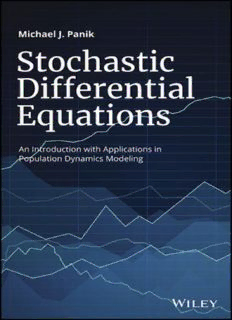
Stochastic Differential Equations: An Introduction with Applications in Population Dynamics Modeling PDF
Preview Stochastic Differential Equations: An Introduction with Applications in Population Dynamics Modeling
StochasticDifferentialEquations Stochastic Differential Equations An Introduction with Applications in Population Dynamics Modeling Michael J. Panik Department of Economics and Finance, Barney School of Business and Public Administration West Hartford, CT, USA Thiseditionfirstpublished2017 ©2017JohnWiley&Sons,Inc. Allrightsreserved.Nopartofthispublicationmaybereproduced,storedinaretrievalsystem,or transmitted,inanyformorbyanymeans,electronic,mechanical,photocopying,recordingor otherwise,exceptaspermittedbylaw.Adviceonhowtoobtainpermisiontoreusematerialfromthis titleisavailableathttp://www.wiley.com/go/permissions. TherightofMichaelJPaniktobeidentifiedastheauthorofthiswork,hasbeenassertedin accordancewithlaw. RegisteredOffice JohnWiley&Sons,Inc.,111RiverStreet,Hoboken,NJ07030,USA EditorialOffice 111RiverStreet,Hoboken,NJ07030,USA Fordetailsofourglobaleditorialoffices,customerservices,andmoreinformationaboutWiley productsvisitusatwww.wiley.com. Wileyalsopublishesitsbooksinavarietyofelectronicformatsandbyprint-on-demand.Some contentthatappearsinstandardprintversionsofthisbookmaynotbeavailableinotherformats. LimitofLiability/DisclaimerofWarranty Thepublisherandtheauthorsmakenorepresentationsorwarrantieswithrespecttotheaccuracyor completenessofthecontentsofthisworkandspecificallydisclaimallwarranties,includingwithout limitationanyimpliedwarrantiesoffitnessforaparticularpurpose.Thisworkissoldwiththe understandingthatthepublisherisnotengagedinrenderingprofessionalservices.Theadviceand strategiescontainedhereinmaynotbesuitableforeverysituation.Inviewofongoingresearch, equipmentmodifications,changesingovernmentalregulations,andtheconstantflowofinformation relatingtotheuseofexperimentalreagents,equipment,anddevices,thereaderisurgedtoreviewand evaluatetheinformationprovidedinthepackageinsertorinstructionsforeachchemical,pieceof equipment,reagent,ordevicefor,amongotherthings,anychangesintheinstructionsor indicationofusageandforaddedwarningsandprecautions.Thefactthatanorganizationorwebsiteis referredtointhisworkasacitationand/orpotentialsourceoffurtherinformationdoesnotmeanthat theauthororthepublisherendorsestheinformationtheorganizationorwebsitemayprovideor recommendationsitmaymake.Further,readersshouldbeawarethatwebsiteslistedinthiswork mayhavechangedordisappearedbetweenwhenthisworkwaswrittenandwhenitisread.No warrantymaybecreatedorextendedbyanypromotionalstatementsforthiswork.Neitherthe publishernortheauthorshallbeliableforanydamagesarisingherefrom. LibraryofCongressCataloging-in-PublicationData Names:Panik,MichaelJ. Title:Stochasticdifferentialequations:anintroductionwithapplications inpopulationdynamicsmodeling/MichaelJ.Panik. Description:1stedition.|Hoboken,NJ:JohnWiley&Sons,Inc.,[2017]| Includesbibliographicalreferencesandindex. Identifiers:LCCN2016056661(print)|LCCN2016057077(ebook)|ISBN 9781119377382(cloth)|ISBN9781119377412(pdf)|ISBN9781119377405(epub) Subjects: LCSH:Stochasticdifferentialequations. Classification:LCCQA274.23.P362017(print)|LCCQA274.23(ebook)|DDC519/.22–dc23 LCrecordavailableathttps://lccn.loc.gov/2016056661 Coverimage:©RKaulitzki/GettyImages CoverdesignbyWiley Setin10/12ptWarnockbySPiGlobal,Pondicherry,India PrintedintheUnitedStatesofAmerica 10 9 8 7 6 5 4 3 2 1 v Contents Dedication x Preface xi SymbolsandAbbreviations xiii 1 MathematicalFoundations1:Point-SetConcepts,SetandMeasure Functions,NormedLinearSpaces,andIntegration 1 1.1 Set Notation and Operations 1 1.1.1 Sets and Set Inclusion 1 1.1.2 Set Algebra 2 1.2 Single-Valued Functions 4 1.3 Real and Extended Real Numbers 6 1.4 Metric Spaces 7 1.5 Limits of Sequences 8 1.6 Point-Set Theory 10 1.7 Continuous Functions 12 1.8 Operations on Sequencesof Sets 13 1.9 Classes of Subsets of Ω 15 1.9.1 Topological Space 15 1.9.2 σ-Algebra of Sets and the Borel σ-Algebra 15 1.10 Set and Measure Functions 17 1.10.1 Set Functions 17 1.10.2 Measure Functions 18 1.10.3 Outer Measure Functions 19 1.10.4 Complete Measure Functions 21 1.10.5 Lebesgue Measure 21 1.10.6 Measurable Functions 23 1.10.7 Lebesgue Measurable Functions 26 1.11 Normed Linear Spaces 27 1.11.1 Space of Bounded Real-Valued Functions 27 1.11.2 Space of Bounded Continuous Real-Valued Functions 28 vi Contents 1.11.3 Some Classical Banach Spaces 29 1.12 Integration 31 1.12.1 Integral of a Non-negative Simple Function 32 1.12.2 Integral of a Non-negative Measurable Function UsingSimple Functions 33 1.12.3 Integral of a Measurable Function 33 1.12.4 Integral of a Measurable Function on a Measurable Set 34 1.12.5 Convergence of Sequencesof Functions 35 2 MathematicalFoundations2:Probability,RandomVariables,and ConvergenceofRandomVariables 37 2.1 Probability Spaces 37 2.2 Probability Distributions 42 2.3 The Expectation of a Random Variable 49 2.3.1 Theoretical Underpinnings 49 2.3.2 Computational Considerations 50 2.4 Moments of a Random Variable 52 2.5 MultipleRandomVariables 54 2.5.1 The Discrete Case 54 2.5.2 The Continuous Case 59 2.5.3 Expectations and Moments 63 2.5.4 The Multivariate Discrete and Continuous Cases 69 2.6 Convergence of Sequencesof Random Variables 72 2.6.1 Almost SureConvergence 73 2.6.2 Convergence inLp,p>0 73 2.6.3 Convergence inProbability 75 2.6.4 Convergence inDistribution 75 2.6.5 Convergence of Expectations 76 2.6.6 Convergence of Sequencesof Events 78 2.6.7 Applications of Convergence of Random Variables 79 2.7 A Coupleof Important Inequalities 80 Appendix 2.A The Conditional Expectation E(X|Y) 81 3 MathematicalFoundations3:StochasticProcesses,Martingales,and BrownianMotion 85 3.1 Stochastic Processes 85 3.1.1 Finite-Dimensional Distributions of a Stochastic Process 86 3.1.2 Selected Characteristics of Stochastic Processes 88 3.1.3 Filtrations of A 89 3.2 Martingales 91 3.2.1 Discrete-Time Martingales 91 3.2.1.1 Discrete-Time Martingale Convergence 93 3.2.2 Continuous-Time Martingales 96 Contents vii 3.2.2.1 Continuous-Time Martingale Convergence 97 3.2.3 Martingale Inequalities 97 3.3 Path Regularity of Stochastic Processes 98 3.4 Symmetric Random Walk 99 3.5 BrownianMotion 100 3.5.1 Standard Brownian Motion 100 3.5.2 BM as a Markov Process 104 3.5.3 Constructing BM 106 3.5.3.1 BM Constructed from N(0, 1) Random Variables 106 3.5.3.2 BM as the Limit of Symmetric Random Walks 108 3.5.4 White Noise Process 109 Appendix 3.A KolmogorovExistence Theorem: Another Look 109 Appendix 3.B Nondifferentiability of BM 110 4 MathematicalFoundations4:StochasticIntegrals,Itô’sIntegral,Itô’s Formula,andMartingaleRepresentation 113 4.1 Introduction 113 4.2 Stochastic Integration: The Itô Integral 114 4.3 One-Dimensional Itô Formula 120 4.4 Martingale Representation Theorem 126 4.5 Multidimensional ItôFormula 127 Appendix 4.A Itô’s Formula 129 Appendix 4.B Multidimensional Itô Formula 130 5 StochasticDifferentialEquations 133 5.1 Introduction 133 5.2 Existence and Uniqueness of Solutions 134 5.3 Linear SDEs 136 5.3.1 Strong Solutions to Linear SDEs 137 5.3.2 Properties of Solutions 147 5.3.3 Solutions to SDEs as MarkovProcesses 152 5.4 SDEsand Stability 154 Appendix 5.A Solutions of Linear SDEs inProduct Form (Evans, 2013; Gard, 1988) 159 5.A.1 Linear Homogeneous Variety 159 5.A.2 Linear Variety 161 Appendix 5.B Integrating Factors and Variation of Parameters 162 5.B.1 Integrating Factors 163 5.B.2 Variation of Parameters 164 6 StochasticPopulationGrowthModels 167 6.1 Introduction 167 6.2 A Deterministic Population Growth Model 168 viii Contents 6.3 A Stochastic Population Growth Model 169 6.4 Deterministic and Stochastic Logistic Growth Models 170 6.5 Deterministic and Stochastic Generalized Logistic Growth Models 174 6.6 Deterministic and Stochastic Gompertz Growth Models 177 6.7 Deterministic and Stochastic Negative Exponential Growth Models 179 6.8 Deterministic and Stochastic Linear Growth Models 181 6.9 Stochastic Square-Root Growth Model with Mean Reversion 182 Appendix6.A DeterministicandStochasticLogisticGrowthModelswithan Allee Effect 184 Appendix 6.B Reducible SDEs 189 7 ApproximationandEstimationofSolutionstoStochastic DifferentialEquations 193 7.1 Introduction 193 7.2 Iterative Schemes forApproximating SDEs 194 7.2.1 The EM Approximation 194 7.2.2 Strong and Weak Convergence of theEM Scheme 196 7.2.3 The Milstein (Second-Order) Approximation 196 7.3 The Lamperti Transformation 199 7.4 Variations on the EMand Milstein Schemes 203 7.5 Local Linearization Techniques 205 7.5.1 The Ozaki Method 205 7.5.2 The Shoji–Ozaki Method 207 7.5.3 The Rate of Convergence of theLocal Linearization Method 211 Appendix 7.A Stochastic Taylor Expansions 212 Appendix 7.B The EM and Milstein Discretizations 217 7.B.1 The EM Scheme 217 7.B.2 The Milstein Scheme 218 Appendix 7.C The Lamperti Transformation 219 8 EstimationofParametersofStochasticDifferentialEquations 221 8.1 Introduction 221 8.2 The Transition Probability Density Function Is Known 222 8.3 The Transition Probability Density Function Is Unknown 227 8.3.1 Parameter Estimation via Approximation Methods 228 8.3.1.1 The EM Routine 228 8.3.1.2 The Ozaki Routine 230 8.3.1.3 The SO Routine 233 Appendix 8.A The ML Technique 235 Appendix 8.B The Log-Normal Probability Distribution 238 Contents ix Appendix 8.C The Markov Property, Transitional Densities,and the Likelihood Function of the Sample 239 Appendix 8.D Change of Variable 241 AppendixA:AReviewofSomeFundamentalCalculusConcepts 245 AppendixB:TheLebesgueIntegral 259 AppendixC:Lebesgue–StieltjesIntegral 261 AppendixD:ABriefReviewofOrdinaryDifferentialEquations 263 References 275 Index 279 x In Memory of John Snizik
Description: